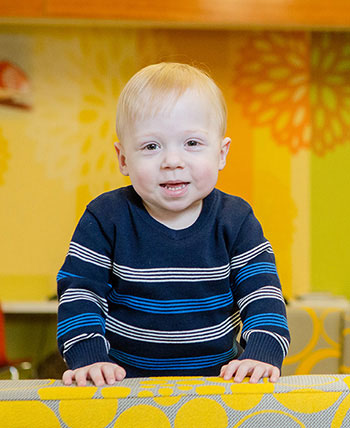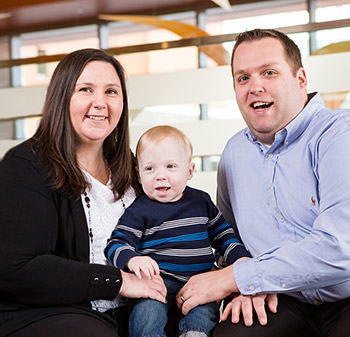Miracle Kid: Ryan Stinson
Boy Pushed to the Brink of Death Twice is a ‘Miracle Times Two’

At just 14-months-old, Ryan Stinson lay connected to a ventilator in Golisano Children’s Hospital. His parents, Melanie and Andy, sat there, helpless, by his side in the pediatric intensive care unit (PICU), and couldn’t help but have flashbacks to their first extended stay at Golisano Children’s Hospital.
Overcoming Short Bowel Syndrome
Rushed to Strong Memorial Hospital after an abnormal ultrasound, Ryan’s heart rate was dropping and the Stinsons had to act quickly to ensure their son’s survival. Melanie and Andy were told to prepare to deliver their son as he had a better chance of survival in the neonatal intensive care unit (NICU). Ryan was born on February 6, 2014, prematurely at 34 weeks weighing just two pounds, nine ounces.
Because Ryan had poor growth in utero, many of his organs were not fully developed, which put him at risk for a number of diseases in the first weeks of life. He was having trouble feeding, and his platelet levels were far below normal. He began to make progress, but after five weeks in the NICU, his little body gave out and became sick, very quickly.
X-ray tests showed that Ryan had necrotizing enterocolitis (NEC), an extremely serious intestinal illness in babies. Portions of Ryan’s small intestine were perforated, causing waste and bacteria to enter his bloodstream and abdominal cavity. Doctors developed a comprehensive treatment plan for Ryan that included multiple surgeries.

Yi-Horng Lee, M.D., along with Marsha Pulhamus and Jennifer Maddison, both pediatric nurse practitioners, followed Ryan’s case closely. Lee’s treatment plan was to remove all of Ryan’s small intestine impacted by NEC, a risky procedure.
Ryan’s condition escalated so quickly that Lee operated right in the NICU. At just over 5 weeks old, Ryan had his first of four surgeries to remove portions of his small intestine. The first surgery was the most intense, with over 75 centimeters of intestine removed.
“Every time Dr. Lee went back in, more small intestine needed to be removed,” said Melanie. “It got to the point where we had to baptize him in the NICU because we didn’t know if he was going to make it.” Ultimately, Lee removed over 80 centimeters from Ryan’s intestinal tract.
Now, the question became whether Ryan could live with such a minimal amount of his digestive tract.
The loss of almost two-thirds of his small bowel meant a diagnosis of short bowel syndrome, something Melanie and Andy knew was evident, which is characterized by a poor absorption of water, vitamins, minerals, proteins, and other key nutrients from food.
“Ryan was at the brink of where we had to wonder if he would ever be able to get off of intravenous fluids because of how much bowel we removed,” said Pulhamus. “Although the surgery was successful, Ryan now had just one-third, or 36 centimeters of intestine left.”
Ultimately, Ryan was able to pull through. He was discharged from the hospital on May 19, 2014, over three months after his birth. Melanie and Andy learned how to mix intravenous fluids, change and sterilize Ryan’s dressings, and put ethanol in his broviac line to prevent infections.
“We would have done anything at that point just to get Ryan home,” said Andy.

Although their house looked like a “mini-NICU,” Andy and Melanie were glad to have Ryan home. Ryan was defying the odds, slowly increasing tube feeds and decreasing intravenous nutrition. In September, 2014, he had begun attending Daystar For Medically Fragile Children, where they could care for his medical needs and coordinate therapies. And in no time, he was rolling over and crawling.
In October, 2014, he underwent his sixth surgery, but this time it was a celebration. Ryan was absorbing enough formula in his g-tube that he no longer needed a central line.
Beating Botulism
Now, it was March 26, 2015. Ryan lay, again, connected to a ventilator.
The morning prior, Melanie and Andy had thought Ryan had looked exhausted and not his active self. After a few trips into the pediatricians, they brought Ryan back to the children’s hospital that evening, where the medical personnel began running tests on him. X-rays hadn’t revealed anything unusual, but he remained in the emergency department where he’d receive more tests.
After a few hours, Ryan began deteriorating, as he was losing control of his body.
“We brought him in Wednesday night, and by 10 a.m. on Thursday, he was completely paralyzed,” said Melanie. “The only thing that remained functioning was his heart.”
Erika Augustine, M.D., assistant professor of Neurology, met Ryan when he was already in the intensive care unit. Ryan had already been put on a ventilator, and Augustine was consulted by doctors in the PICU to evaluate for neurological causes of his condition. She worked closely with other neuromuscular specialists, including David Herrmann, M.D.

After running countless tests with inconclusive results, Hermann performed a nerve conduction study, which measured the speed at which an electrical impulse moved through his nerves. Ryan was subsequently diagnosed with infantile botulism, an extremely rare illness seen in only 100 or so people throughout the United States each year.
“One of the major challenges in caring for Ryan was moving beyond common causes, to very, very rare diagnoses that required specialized testing and specialized treatments,” recalled Augustine.
The disease is frightening because it causes muscle weakness and breathing problems. Due to its severity, it’s critical to recognize it early. Augustine and her team phoned to the California Department of Health, the only center with the immunoglobulin to treat botulism, to get it on a plane to Rochester.
The call was made on a Saturday, March 28, 2015. By Sunday morning, Ryan was receiving the immunoglobulin through an IV. After a two month hospitalization, Ryan made a dramatic recovery.
“Ryan had already been through a lifetime of medical issues in just 14 months prior to his botulism,” said Augustine. “He’s truly a remarkable child having survived two prolonged ICU admissions with two separate rare diagnoses.”
Ryan’s botulism reverted him back to the state of a three-month-old, and he’s been tasked with relearning everything from crawling to swallowing. Ryan continues to make new developmental strides every day. He has a slight speech delay, and still requires tube feedings, but Melanie and Andy know he will overcome that, as he has with every other obstacle that has been in his way.
“We feel incredibly lucky to have Golisano Children’s Hospital in our community,” said Andy. “Because of them, Ryan will be able to go to school, have kids, and live a normal life someday.”